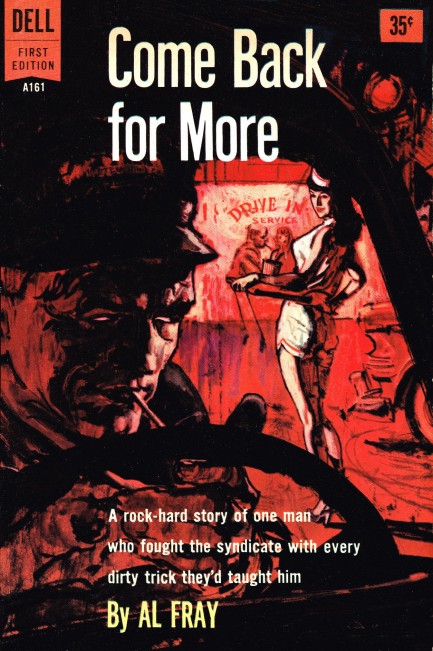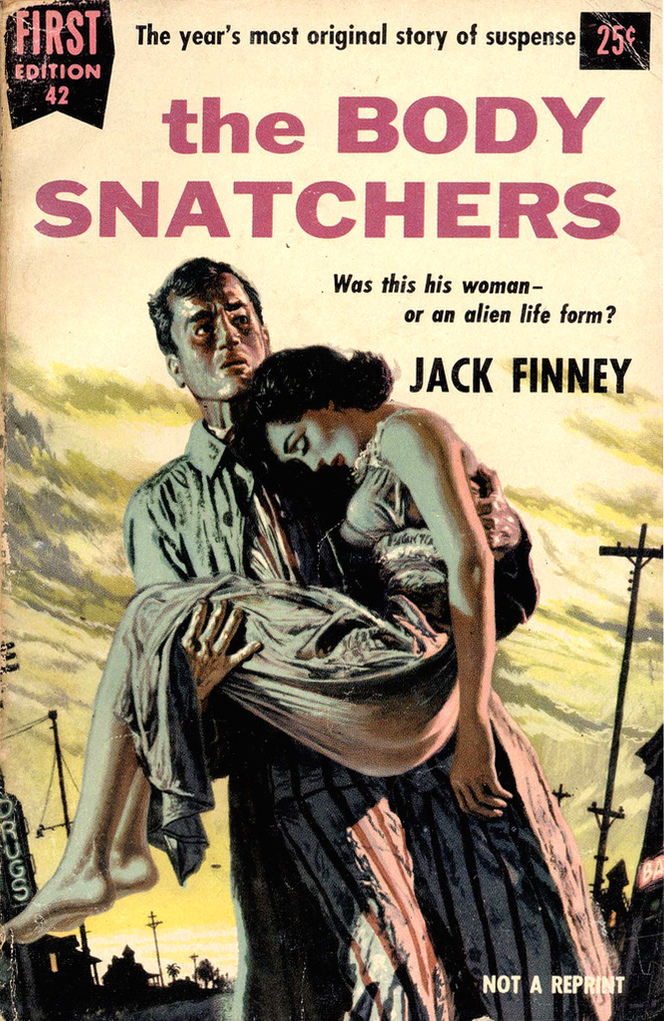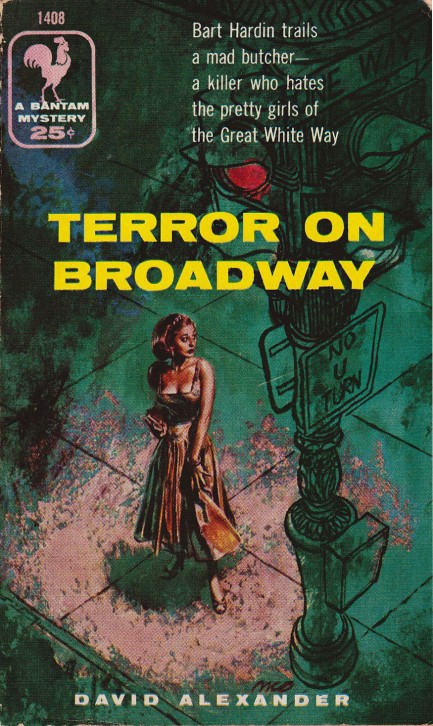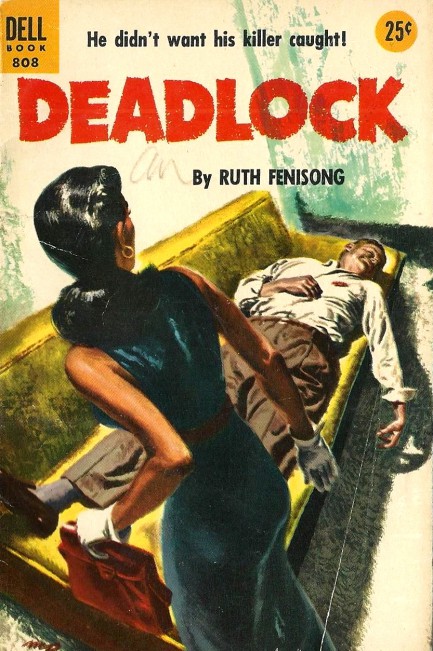 How do you fix a malfunctioning operating system? Become an expert trouble shooter. 
Al Fray's 1958 novel Come Back for More is fronted by John McDermott art. It's unusual and a bit sinister, and though it doesn't really fit the story, we love it. The novel tells the tale of Swede Anderson, a soft, chubby, civic-minded bank teller in River City who testifies against the bank's robbers and realizes afterward that the cops who encouraged him to testify and told him everything would be fine never cared about him and never had a plan to keep him safe from retribution. After his car is blown to bits with the wrong person inside he escapes town on a box freight, rides the rails, works odd jobs, and generally goes off-grid.
He returns four years later—forty pounds lighter, much tougher, infinitely more cynical, and with a broken nose and scar that change his facial appearance. His name is now Warner McCarthy, and he wants to even the score. He sets into motion a plan to get close to the crooks who robbed the bank and somehow get revenge. He soon learns that they're ensconced in a local trucking firm and operate the local Teamsters union. What follows is a sort of deep cover thriller, with McCarthy being pulled into the center of the corrupt syndicate, and deeper into the their illegal enterprises. Along the way he meets a woman—pro forma—who happens to own a competing trucking company the crooks want put out of business.
This was a pretty good tale. It's like a precursor to the Jack Reacher books in the sense that McCarthy, for all the murderous thugs he deals with, is always in control. Many people die, but the worst he deals with is a hurt hand. Telling you this isn't a spoiler because if you're an experienced reader of crime novels it'll become clear pretty quickly that Fray's plan is to show how much smarter and more determined his hero is than the villains. We were fine with it. The Reacher books prove that some modern readers like a sort of invulnerability. Well, it worked in 1958 too. Not top notch, but worth a read.
 Jack Finney's alien invasion novel is filled with close encounters of the worst kind. 
This paperback cover was painted by John McDermott, aka J.M. Ryan, and it's iconic, as is Jack Finney's novel The Body Snatchers. You know the story. Aliens come from space in the form of pods that grow into exact duplicates of humans, who are replaced and dissolved into dust. Finney deftly blends sci-fi and horror, and the result is great—simply put. As with many macabre tales, the fear factor subsides somewhat once the monsters move from the shadows to center stage, but it's still very good even after that point.
The Body Snatchers became a movie in 1956, 1978, 1993, and 2007. The ’56 Don Siegel version is famously considered by many to be a direct Cold War allegory, and is the best of the quartet of adaptations, but the ’78 iteration is damned good too. In terms of metaphor, the book seems to be less about the Cold War and more clearly about the overall loss of freedom in American society. Other than the freedom to buy things that process continues to accelerate. Finney claims the book is just popular entertainment, so we'll take him at his word, but he wouldn't be the first writer to unwittingly let subtext sneak into his work. The novel originally appeared in 1955 as a serial in Colliers Magazine, with this Dell edition coming the same year. The cover artist McDermott is someone we've featured before, and if you're curious you can see more of his nice work here and here. Some book dealers actually try to sell this edition for $100, if you can believe that. Money snatchers is more like it. Buy a cheap new edition, read it, and enjoy it.
 Aspiring actress gets shot on Broadway. 
She was looking to get a shot on Broadway, not get shot, but you have to be 100% clear or people will get confused. Especially a guy like Waldo, the crazed mutiliation killer of David Alexander's Terror on Broadway. Waldo, who taunts the police with snide notes, has knocked off four women, all in the Broadway theatre district, and he has more in his sights unless hero Bart Hardin can stop him. Hardin isn't a private detective or cop—he's the editor of a newspaper, but he's tough enough for the task. Unrealistically so to us, though this is explained by his youth as a boxer and his stint in the military. Overall, Terror on Broadway is pretty heavy stuff for 1954, and the book was banned for a time in Australia. The art on this edition, though, is uncommonly pretty. It was painted by John McDermott, aka J.M. Ryan, who was an animator for Walt Disney before branching out into cover work. He later went on to write his own novels and make a couple of films, so the guy was multi-talented. We'll run into him again down the line, we're sure.
 Now if I put the remote over the blood and ESPN on the tv it should be days before anyone notices he’s dead. 
We’ve seen this cover on a few other sites, but we love it, so we thought we’d share it anyway. Deadlock concerns a New York City detective (Ruth Fenisong’s ongoing character Gridley Nelson—yes, Gridley) trying to solve the murder of a philanthropist who turns out to be less of a saint than previously thought, and whose murder is followed by a second and third that eventually shed light on the mystery. 1953, with John McDermott the hand behind this art, with its deftly executed overhead perspective.
|
 |

The headlines that mattered yesteryear.
1939—Holiday Records Strange Fruit
American blues and jazz singer Billie Holiday records "Strange Fruit", which is considered to be the first civil rights song. It began as a poem written by Abel Meeropol, which he later set to music and performed live with his wife Laura Duncan. The song became a Holiday standard immediately after she recorded it, and it remains one of the most highly regarded pieces of music in American history. 1927—Mae West Sentenced to Jail
American actress and playwright Mae West is sentenced to ten days in jail for obscenity for the content of her play Sex. The trial occurred even though the play had run for a year and had been seen by 325,000 people. However West's considerable popularity, already based on her risque image, only increased due to the controversy. 1971—Manson Sentenced to Death
In the U.S, cult leader Charles Manson is sentenced to death for inciting the murders of Sharon Tate and several other people. Three accomplices, who had actually done the killing, were also sentenced to death, but the state of California abolished capital punishment in 1972 and neither they nor Manson were ever actually executed. 1923—Yankee Stadium Opens
In New York City, Yankee Stadium, home of Major League Baseball's New York Yankees, opens with the Yankees beating their eternal rivals the Boston Red Sox 4 to 1. The stadium, which is nicknamed The House that Ruth Built, sees the Yankees become the most successful franchise in baseball history. It is eventually replaced by a new Yankee Stadium and closes in September 2008.
|

|
|

It's easy. We have an uploader that makes it a snap. Use it to submit your art, text, header, and subhead. Your post can be funny, serious, or anything in between, as long as it's vintage pulp. You'll get a byline and experience the fleeting pride of free authorship. We'll edit your post for typos, but the rest is up to you. Click here to give us your best shot.

|
|












































































